Influence of the PVC of Glass Fiber Powder on the Properties of a Thermochromic Waterborne Coating for Chinese Fir Boards
Abstract
1. Introduction
2. Materials and Methods
2.1. Experimental Materials
2.2. Preparation of Microcapsules
2.3. Preparation of Coatings
2.4. Testing and Characterization
3. Results and Discussion
3.1. Influence of the PVC of Glass Fiber Powder on Optical Properties
3.2. Influence of PVC of Glass fiber Powder on Mechanical Properties
3.3. Influence of PVC of Glass Fiber Powder on Liquid Resistance
3.4. Influence of the PVC of Glass Fiber Powder on Temperature Change under Natural Cooling
3.5. Influence of Time on Discoloration of the Waterborne Coating with Thermal Insulation Efficacy
3.6. Microstructure and Infrared Spectrum Analysis
4. Conclusions
Author Contributions
Funding
Acknowledgments
Conflicts of Interest
References
- Ma, X.G.; Wang, L.; Li, L.; Bian, L.R.; Yang, W.F.; Meng, Q.T. The novel thermochromic and energy-storage microcapsules with significant extension of color change range to different tones. J. Macromol. Sci. Part A. 2019, 56, 588–596. [Google Scholar] [CrossRef]
- Xiong, X.Q.; Yuan, Y.Y.; Niu, Y.T.; Zhang, L.T. Research on the effects of roughness on the tactile properties of rice straw particleboard surface. Sci. Adv. Mater. 2020, 12, 795–801. [Google Scholar] [CrossRef]
- Wu, Y.; Zhou, J.C.; Huang, Q.T.; Yang, F.; Wang, Y.J.; Liang, X.M.; Li, J.Z. Study on the colorimetry properties of transparent wood prepared from six wood species. ACS Omega 2020, 5, 1782–1788. [Google Scholar] [CrossRef] [PubMed]
- Xiong, X.Q.; Ma, Q.R.; Ren, J. The performance optimization of oriented strand board veneer technology. Coatings 2020, 10, 511. [Google Scholar] [CrossRef]
- Oberhofnerova, E.; Hysek, S.; Panek, M.; Bohm, M. Effect of artificial weathering and temperature cycling on the performance of coating systems used for wooden windows. J. Coat. Technol. Res. 2018, 15, 851–865. [Google Scholar] [CrossRef]
- Zhao, Z.Y.; Huang, C.X.; Wu, D.; Chen, Z.; Zhu, N.; Gui, C.S.; Zhang, M.; Umemura, K.; Yong, Q. Utilization of enzymatic hydrolysate from corn stover as a precursor to synthesize an eco-friendly plywood adhesive. Ind. Crop. Prod. 2020, 152, 112501. [Google Scholar] [CrossRef]
- Zhu, X.D.; Liu, Y.; Li, Z.; Wang, W.C. Thermochromic microcapsules with highly transparent shells obtained through in-situ polymerization of urea formaldehyde around thermochromic cores for smart wood coatings. Sci. Rep. 2018, 8, 4015. [Google Scholar] [CrossRef]
- Xu, W.; Fang, X.Y.; Han, J.T.; Wu, Z.H.; Zhang, J.L. Effect of coating thickness on sound absorption property of four wood species commonly used for piano soundboards. Wood Fiber Sci. 2020, 52, 28–43. [Google Scholar] [CrossRef]
- Hu, L.; Lyu, S.Y.; Fu, F.; Huang, J.D.; Wang, S.Q. Preparation and properties of multifunctional thermochromic energy-storage wood materials. J. Mater. Sci. 2016, 51, 2716–2726. [Google Scholar] [CrossRef]
- Pedaballi, S.; Li, C.C.; Song, Y.J. Dispersion of microcapsules for the improved thermochromic performance of smart coatings. RSC Adv. 2019, 9, 24175–24183. [Google Scholar] [CrossRef]
- Baumard, T.; Menary, G.; De Almeida, O.; Martin, P.; Schmidt, F.; Bikard, J. Experimental characterization and modeling of the temperature and rate-dependent shear behaviour of powder-impregnated glass fiber/PA66 woven semipregs. Compos. Sci. Technol. 2019, 180, 23–32. [Google Scholar] [CrossRef]
- Yang, S.; Heyl, H.; Homa, D.; Pickrell, G.; Wang, A.B. Powder-in-tube reactive molten-core fabrication of glass-clad BaO-TiO2-SiO2 glass—Ceramic fibers. Materials 2020, 13, 395. [Google Scholar] [CrossRef] [PubMed]
- Zhai, H.; Zhou, X.D.; Fang, L.; Lu, A. Study on mechanical properties of powder impregnated glass fiber reinforced poly(phenylene sulphide) by injection molding at various temperatures. J. Appl. Polym. Sci. 2010, 115, 2019–2027. [Google Scholar] [CrossRef]
- Algburi, A.H.M.; Sheikh, M.N.; Hadi, M.N.S. Mechanical properties of steel, glass, and hybrid fiber reinforced reactive powder concrete. Front. Struct. Civ. Eng. 2019, 13, 998–1006. [Google Scholar] [CrossRef]
- Panin, S.V.; Kornienko, L.A.; Huang, Q.; Buslovich, D.-G.; Bochkareva, S.-A.; Alexenko, V.-O.; Panov, I.-L.; Berto, F. Effect of adhesion on mechanical and tribological properties of glass fiber composites, based on ultra-high molecular weight polyethylene powders with various initial particle sizes. Materials 2020, 13, 1602. [Google Scholar] [CrossRef] [PubMed]
- Kou, S.C.; Xing, F. The effect of recycled glass powder and reject fly ash on the mechanical properties of fibre-reinforced ultrahigh performance concrete. Adv. Mater. Sci. Eng. 2012, 2012, 263243. [Google Scholar] [CrossRef]
- Wang, S.W.; Liu, Y.Q.; Chen, K.; Xue, P.; Lin, X.D.; Jia, M.Y. Thermal and mechanical properties of the continuous glass fibers reinforced PVC composites prepared by the wet powder impregnation technology. J. Polym. Res. 2020, 27, 82. [Google Scholar] [CrossRef]
- Fang, Y.; Cui, P.; Ding, Z.; Zhu, J.X. Properties of a magnesium phosphate cement-based fire-retardant coating containing glass fiber or glass fiber powder. Constr. Build. Mater. 2018, 162, 553–560. [Google Scholar] [CrossRef]
- Yan, X.X.; Chang, Y.J. Investigation of waterborne thermochromic topcoat film with color-changing microcapsules on Chinese fir surface. Prog. Org. Coat. 2019, 136, 105262. [Google Scholar] [CrossRef]
- GB/T 4893.8-2013 Test of Surface Coatings of Furniture—Part 8: Determination of Wearability; Standardization Administration of the People’s Republic of China: Beijing, China, 2013; pp. 1–8. (In Chinese)
- Kasyanenko, I.M.; Kramarenko, V.Y. The effect of pigment volume concentration on film formation and the mechanical properties of coatings based on water-dispersion paint and varnish materials. Mech. Compos. Mater. 2018, 53, 767–780. [Google Scholar] [CrossRef]
- Relosi, N.; Neuwald, O.A.; Zattera, A.J.; Piazza, D.; Kunst, S.R.; Birriel, E.J. Effect of addition of clay minerals on the properties of epoxy/polyester powder coatings. Polimeros 2018, 28, 355–367. [Google Scholar] [CrossRef]
- Li, X.L.; Li, G.Z. Effect of latex powder and glass fibers on the performance of glazed hollow bead thermal insulation materials. Sci. Eng. Compos. Mater. 2015, 22, 279–286. [Google Scholar] [CrossRef]
- Zheng, X.L.; Zhu, Z.H.; Li, X.M. The absorbing properties of Fe73.5Cu1Nb3Si13.5B9 amorphous powder/S-glass fiber-reinforced epoxy composite panels. Rare Met. 2013, 32, 294–298. [Google Scholar] [CrossRef]
- Granqvist, C.G.; Lansaker, P.C.; Mlyuka, N.R.; Niklasson, G.A.; Avendano, E. Progress in chromogenics: New results for electrochromic and thermochromic materials and devices. Sol. Energy Mater. Sol. Cells 2009, 93, 2032–2039. [Google Scholar] [CrossRef]
- Melinte, G.; Baia, L.; Simon, V.; Simon, S. Hydrogen peroxide versus water synthesis of bioglass-nanocrystalline hydroxyapatite composites. J. Mater. Sci. 2011, 46, 7393–7400. [Google Scholar] [CrossRef]
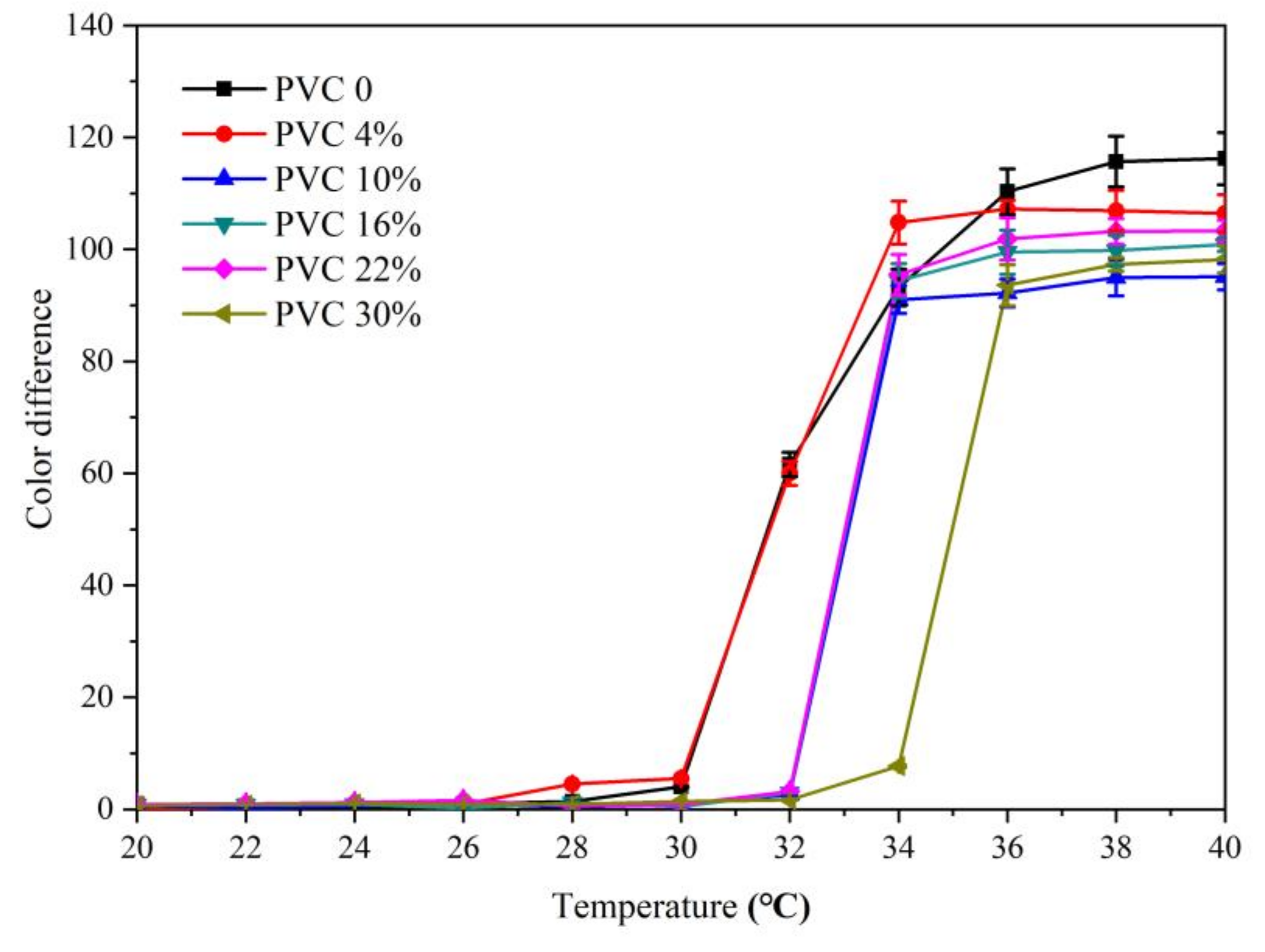

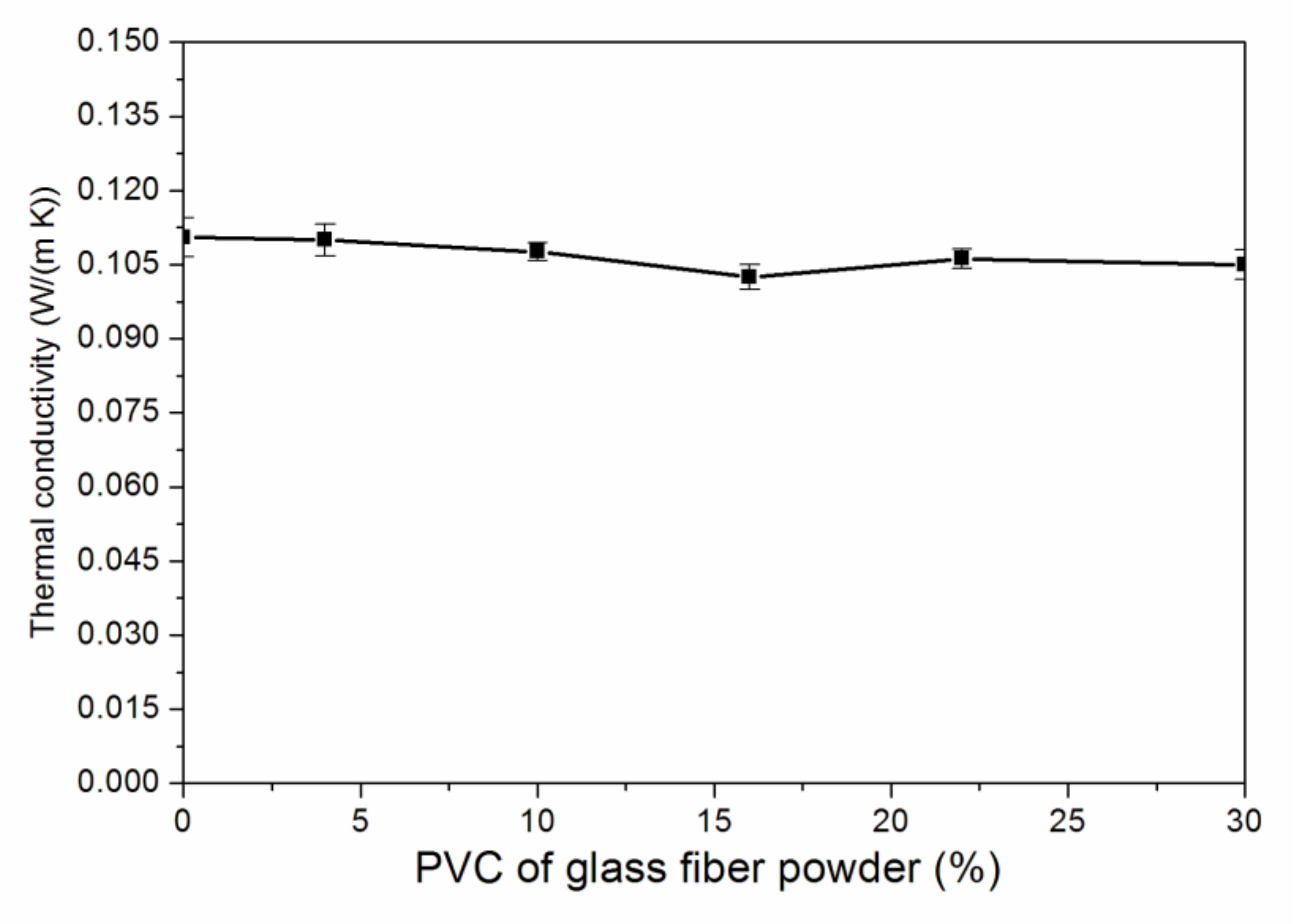
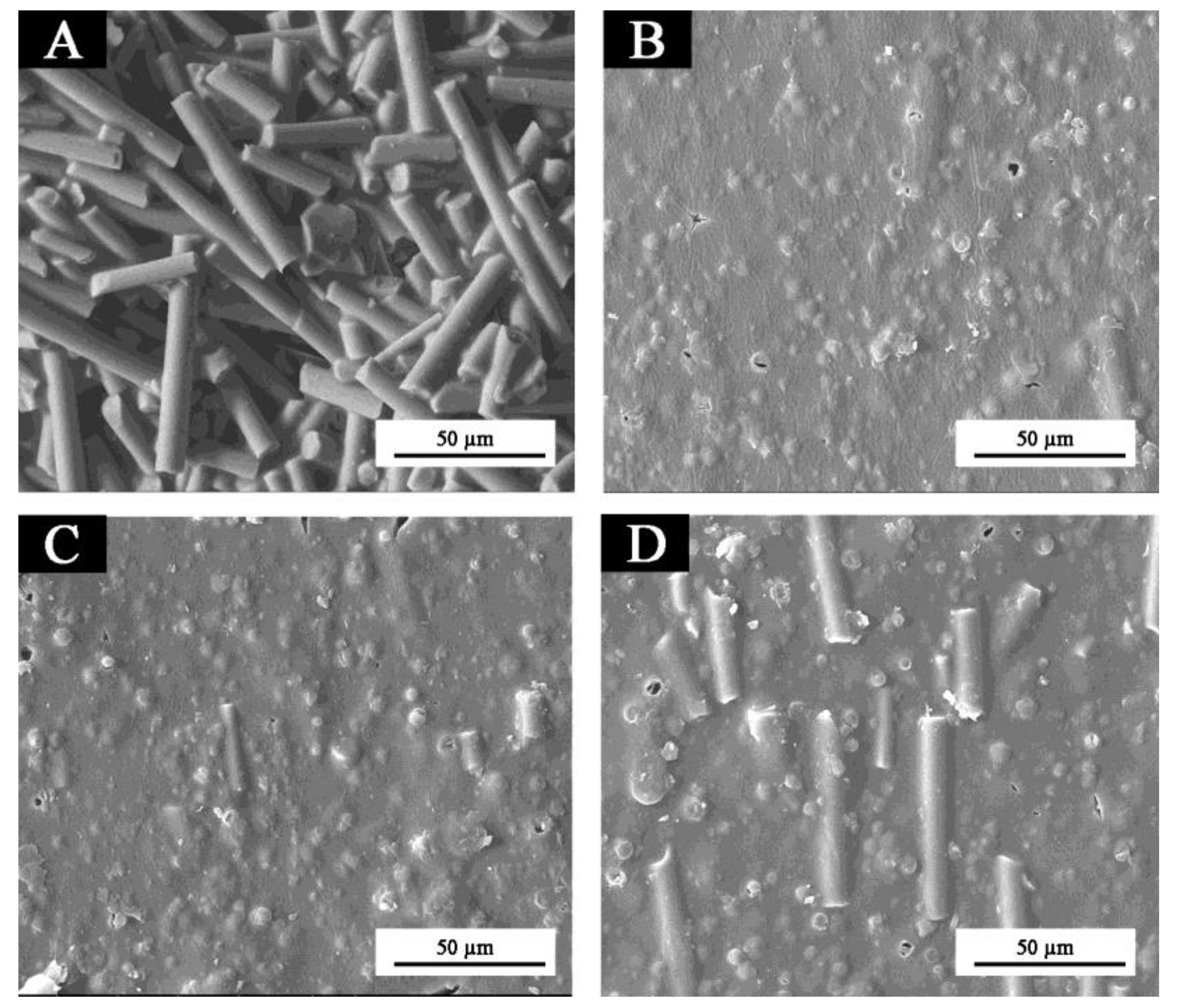
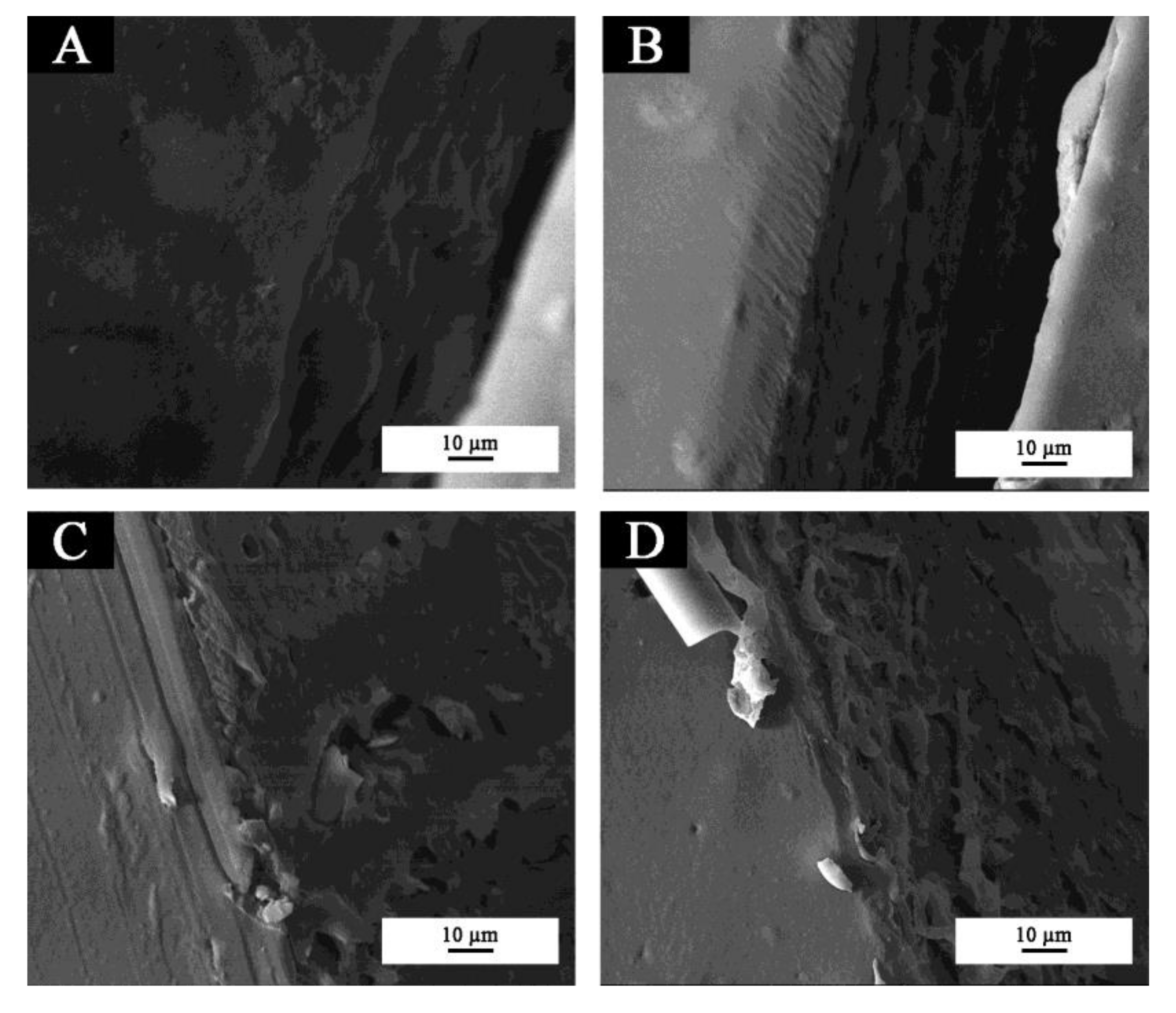
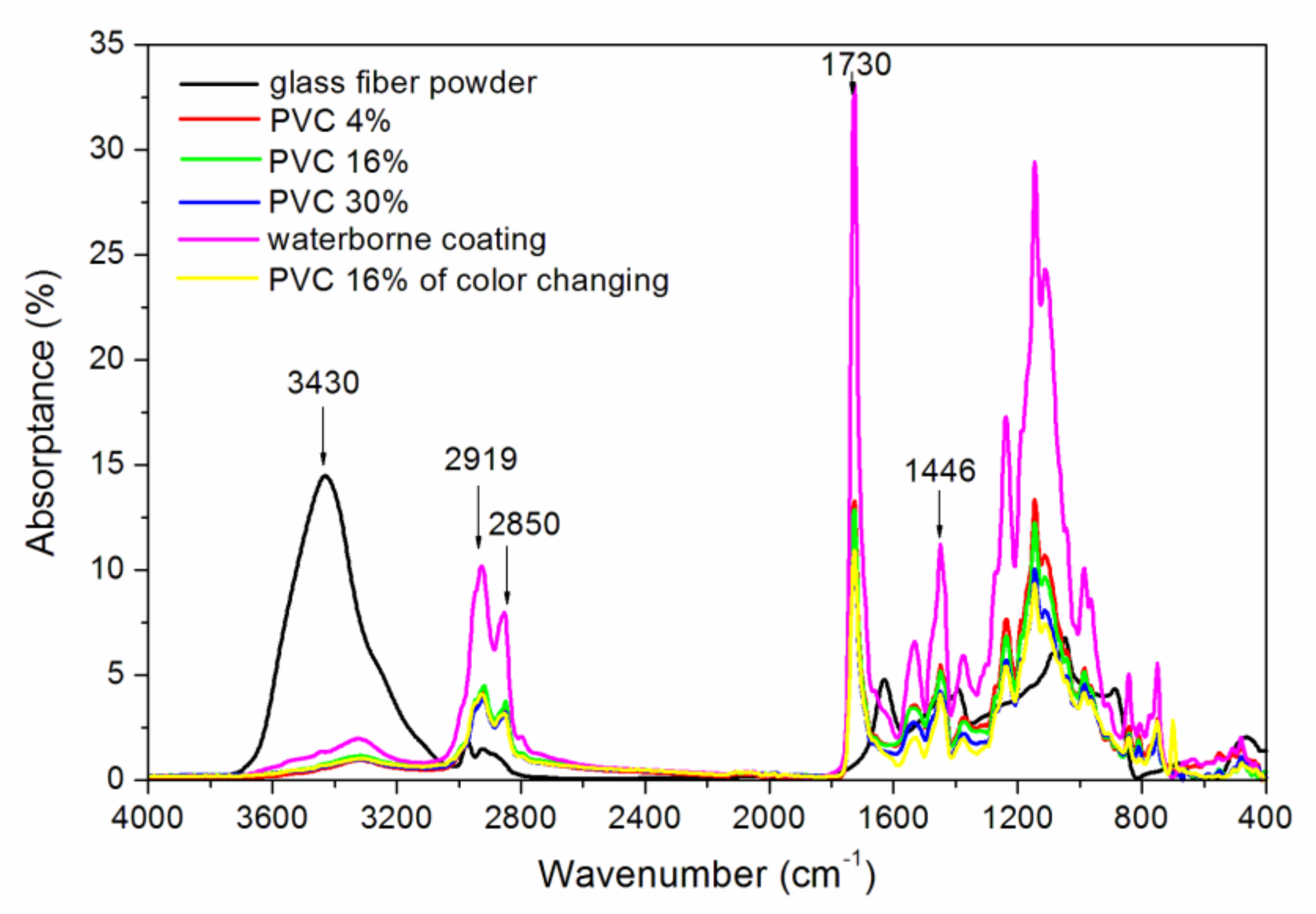
| Sample (#) | PVC of Glass Fiber Powder (%) | Weight of Glass Fiber Powder (g) | Weight of Thermochromic Microcapsule (g) | Weight of Waterborne Topcoat (g) | Weight of Waterborne Primer (g) | Total weight of Waterborne Coating (g) |
|---|---|---|---|---|---|---|
| 1 | 0 | 0 | 5.0 | 95.0 | 100.0 | 200.0 |
| 2 | 4.0 | 1.0 | 5.0 | 94.0 | 100.0 | 200.0 |
| 3 | 10.0 | 3.0 | 5.0 | 92.0 | 100.0 | 200.0 |
| 4 | 16.0 | 5.0 | 5.0 | 90.0 | 100.0 | 200.0 |
| 5 | 22.0 | 7.0 | 5.0 | 88.0 | 100.0 | 200.0 |
| 6 | 30.0 | 10.0 | 5.0 | 85.0 | 100.0 | 200.0 |
| PVC of Glass Fiber (%) | Chroma Parameters | 18 °C | 20 °C | 22 °C | 24 °C | 26 °C | 28 °C | 30 °C | 32 °C | 34 °C | 36 °C | 38 °C | 40 °C |
|---|---|---|---|---|---|---|---|---|---|---|---|---|---|
| 0 | L | 51.10 ± 1.69 | 51.30 ± 1.69 | 50.90 ± 1.69 | 51.00 ± 1.69 | 50.80 ± 1.69 | 50.90 ± 1.69 | 51.80 ± 1.69 | 77.40 ± 2.57 | 90.50 ± 3.29 | 95.90 ± 3.29 | 97.50 ± 3.29 | 98.10 ± 3.29 |
| a | 64.00 ± 2.16 | 63.60 ± 2.16 | 63.50 ± 2.16 | 63.80 ± 2.16 | 63.10 ± 2.16 | 62.90 ± 2.16 | 60.30 ± 2.16 | 15.90 ± 0.29 | −6.00 ± 0.08 | −18.80 ± 0.29 | −22.20 ± 0.50 | −23.70 ± 0.50 | |
| b | 41.70 ± 1.31 | 42.50 ± 1.31 | 41.50 ± 1.31 | 41.70 ± 1.31 | 41.30 ± 1.31 | 42.50 ± 1.31 | 42.90 ± 1.31 | 69.70 ± 2.16 | 89.00 ± 2.16 | 99.10 ± 3.29 | 103.40 ± 3.15 | 101.70 ± 3.15 | |
| c | 76.40 ± 2.57 | 76.50 ± 2.57 | 75.80 ± 2.57 | 76.20 ± 2.57 | 75.50 ± 2.57 | 75.90 ± 2.57 | 74.10 ± 2.57 | 71.50 ± 2.57 | 89.20 ± 2.16 | 100.90 ± 3.15 | 105.70 ± 3.15 | 104.40 ± 3.15 | |
| H | 33.10 ± 0.83 | 33.70 ± 0.83 | 33.10 ± 0.83 | 33.10 ± 0.83 | 33.10 ± 0.83 | 34.00 ± 0.83 | 35.40 ± 0.83 | 77.10 ± 2.57 | 93.80 ± 3.29 | 100.70 ± 3.15 | 102.10 ± 3.15 | 103.10 ± 3.15 | |
| 4.0 | L | 51.80 ± 1.69 | 51.80 ± 1.69 | 51.70 ± 1.69 | 51.90 ± 1.69 | 52.00 ± 1.69 | 53.80 ± 1.69 | 54.20 ± 1.69 | 78.60 ± 2.57 | 95.60 ± 3.29 | 96.40 ± 3.29 | 96.20 ± 3.29 | 95.90 ± 3.29 |
| a | 60.20 ± 2.16 | 60.30 ± 2.16 | 60.00 ± 2.16 | 59.70 ± 1.69 | 59.70 ± 1.69 | 56.40 ± 1.69 | 55.40 ± 1.69 | 12.50 ± 0.29 | −20.60 ± 0.50 | −22.00 ± 0.50 | −22.00 ± 0.50 | −21.80 ± 0.50 | |
| b | 42.80 ± 1.31 | 42.90 ± 1.31 | 42.70 ± 1.31 | 42.20 ± 1.31 | 43.50 ± 1.31 | 44.20 ± 1.31 | 44.00 ± 1.31 | 67.50 ± 2.16 | 93.20 ± 3.29 | 95.30 ± 3.29 | 94.80 ± 3.29 | 94.40 ± 3.29 | |
| c | 73.90 ± 2.57 | 74.10 ± 2.57 | 73.70 ± 2.57 | 73.10 ± 2.57 | 73.90 ± 2.57 | 71.70 ± 2.57 | 70.80 ± 2.57 | 68.60 ± 2.16 | 95.50 ± 3.29 | 97.90 ± 3.29 | 97.30 ± 3.29 | 96.90 ± 3.29 | |
| H | 35.4 ± 0.83 | 35.4 ± 0.83 | 35.4 ± 0.83 | 35.2 ± 0.83 | 36.0 ± 0.83 | 38.0 ± 0.83 | 38.4 ± 0.83 | 79.40 ± 0.83 | 102.40 ± 3.15 | 102.90 ± 3.15 | 103.00 ± 3.15 | 103.00 ± 3.15 | |
| 10.0 | L | 54.60 ± 1.69 | 54.40 ± 1.69 | 54.50 ± 1.69 | 54.50 ± 1.69 | 54.30 ± 1.69 | 54.30 ± 1.69 | 54.40 ± 1.69 | 55.60 ± 1.69 | 92.40 ± 3.29 | 93.20 ± 3.29 | 93.90 ± 3.29 | 94.30 ± 3.29 |
| a | 56.30 ± 1.69 | 56.70 ± 1.69 | 56.10 ± 1.69 | 55.80 ± 1.69 | 56.50 ± 1.69 | 56.10 ± 1.69 | 55.60 ± 1.69 | 53.90 ± 1.69 | −14.40 ± 0.45 | −15.50 ± 0.45 | −17.50 ± 0.45 | −17.60 ± 0.45 | |
| b | 44.00 ± 1.31 | 43.40 ± 1.31 | 43.90 ± 1.31 | 43.70 ± 1.31 | 43.30 ± 1.31 | 44.40 ± 1.31 | 43.60 ± 1.31 | 43.90 ± 1.31 | 87.00 ± 2.16 | 87.00 ± 2.16 | 89.00 ± 2.16 | 88.80 ± 2.16 | |
| c | 71.40 ± 2.57 | 71.40 ± 2.57 | 71.30 ± 2.57 | 70.90 ± 2.57 | 71.30 ± 2.57 | 71.60 ± 2.57 | 70.70 ± 2.57 | 69.50 ± 2.16 | 88.20 ± 2.16 | 88.40 ± 2.16 | 90.70 ± 2.16 | 90.60 ± 2.16 | |
| H | 38.00 ± 0.83 | 37.40 ± 0.83 | 38.00 ± 0.83 | 38.10 ± 0.83 | 37.40 ± 0.83 | 38.30 ± 0.83 | 38.10 ± 0.83 | 39.10 ± 0.83 | 99.30 ± 3.29 | 100.00 ± 3.15 | 101.10 ± 3.15 | 101.20 ± 3.15 | |
| 16.0 | L | 52.2 ± 1.69 | 51.9 ± 1.69 | 51.9 ± 1.69 | 52.0 ± 1.69 | 52.2 ± 1.69 | 52.2 ± 1.69 | 52.4 ± 1.69 | 53.8 ± 1.69 | 91.2 ± 3.29 | 93.2 ± 3.29 | 93.3 ± 3.29 | 93.6 ± 3.29 |
| a | 56.00 ± 1.69 | 56.50 ± 1.69 | 56.30 ± 1.69 | 56.80 ± 1.69 | 56.20 ± 1.69 | 56.80 ± 1.69 | 55.90 ± 1.69 | 53.50 ± 1.69 | −16.10 ± 0.45 | −20.70 ± 0.45 | −20.80 ± 0.45 | −21.40 ± 0.45 | |
| b | 41.10 ± 1.31 | 40.50 ± 1.31 | 40.40 ± 1.31 | 40.70 ± 1.31 | 41.20 ± 1.31 | 40.20 ± 1.31 | 40.70 ± 1.31 | 41.50 ± 1.31 | 87.90 ± 2.16 | 89.50 ± 2.16 | 89.80 ± 2.16 | 90.80 ± 3.29 | |
| c | 69.50 ± 2.16 | 69.50 ± 2.16 | 69.30 ± 2.16 | 69.90 ± 2.16 | 69.70 ± 2.16 | 69.60 ± 2.16 | 69.20 ± 2.16 | 67.70 ± 2.16 | 89.30 ± 2.16 | 91.90 ± 3.29 | 92.20 ± 3.29 | 93.30 ± 3.29 | |
| H | 36.20 ± 0.83 | 35.60 ± 0.83 | 35.60 ± 0.83 | 35.60 ± 0.83 | 36.20 ± 0.83 | 35.30 ± 0.83 | 36.00 ± 0.83 | 37.70 ± 0.83 | 100.40 ± 3.15 | 103.00 ± 3.15 | 103.00 ± 3.15 | 103.20 ± 3.15 | |
| 22.0 | L | 54.10 ± 1.69 | 53.80 ± 1.69 | 53.70 ± 1.69 | 53.20 ± 1.69 | 53.50 ± 1.69 | 53.80 ± 1.69 | 53.90 ± 1.69 | 55.10 ± 1.69 | 93.90 ± 3.29 | 96.30 ± 3.29 | 96.60 ± 3.29 | 96.80 ± 3.29 |
| a | 57.90 ± 1.69 | 57.80 ± 1.69 | 57.60 ± 1.69 | 58.70 ± 1.69 | 58.10 ± 1.69 | 57.40 ± 1.69 | 57.20 ± 1.69 | 55.00 ± 1.69 | 16.50 ± 0.45 | −21.30 ± 0.45 | −22.40 ± 0.45 | −22.50 ± 0.45 | |
| b | 43.60 ± 1.31 | 42.80 ± 1.31 | 42.70 ± 1.31 | 43.30 ± 1.31 | 42.10 ± 1.31 | 43.80 ± 1.31 | 43.30 ± 1.31 | 44.50 ± 1.31 | 88.30 ± 2.16 | 91.90 ± 3.29 | 92.60 ± 3.29 | 92.50 ± 3.29 | |
| c | 72.50 ± 2.57 | 72.00 ± 2.57 | 71.80 ± 2.57 | 73.00 ± 2.57 | 71.80 ± 2.57 | 72.30 ± 2.57 | 71.70 ± 2.57 | 70.80 ± 2.57 | 89.90 ± 2.16 | 94.30 ± 3.29 | 95.30 ± 3.29 | 95.20 ± 3.29 | |
| H | 37.00 ± 0.83 | 36.50 ± 0.83 | 36.50 ± 0.83 | 36.40 ± 0.83 | 35.90 ± 0.83 | 37.30 ± 0.83 | 37.10 ± 0.83 | 38.90 ± 0.83 | 100.50 ± 3.15 | 103.00 ± 3.15 | 103.60 ± 3.15 | 103.60 ± 3.15 | |
| 30.0 | L | 53.70 ± 1.69 | 54.10 ± 1.69 | 53.90 ± 1.69 | 54.00 ± 1.66 | 53.80 ± 1.69 | 53.80 ± 1.69 | 53.60 ± 1.69 | 54.40 ± 1.69 | 57.20 ± 1.66 | 92.70 ± 3.29 | 93.90 ± 3.29 | 94.40 ± 3.29 |
| a | 55.20 ± 1.69 | 54.60 ± 1.69 | 54.60 ± 1.69 | 54.20 ± 1.69 | 54.60 ± 1.69 | 54.40 ± 1.69 | 54.10 ± 1.69 | 53.60 ± 1.66 | 48.60 ± 1.31 | −17.40 ± 0.45 | −20.40 ± 0.45 | −21.10 ± 0.45 | |
| b | 41.90 ± 1.31 | 42.00 ± 1.31 | 42.40 ± 1.31 | 41.80 ± 1.31 | 41.20 ± 1.31 | 42.30 ± 1.31 | 41.00 ± 1.31 | 41.90 ± 1.31 | 43.80 ± 1.31 | 86.30 ± 2.16 | 88.10 ± 2.16 | 88.40 ± 2.16 | |
| c | 69.30 ± 2.16 | 68.90 ± 2.16 | 69.10 ± 2.16 | 68.50 ± 2.16 | 68.50 ± 2.16 | 68.90 ± 2.16 | 67.90 ± 2.16 | 68.00 ± 2.16 | 65.50 ± 2.16 | 88.10 ± 2.16 | 90.50 ± 3.29 | 90.90 ± 3.29 | |
| H | 37.20 ± 0.83 | 37.50 ± 0.83 | 37.80 ± 0.83 | 37.60 ± 0.83 | 37.00 ± 0.83 | 37.80 ± 0.83 | 37.10 ± 0.83 | 38.00 ± 0.83 | 42.00 ± 1.31 | 101.40 ± 3.15 | 103.00 ± 3.15 | 103.40 ± 3.15 |
| PVC of Glass Fiber Powder (%) | 20° Gloss (%) | 60° Gloss (%) | 85° Gloss (%) |
|---|---|---|---|
| 0 | 2.80 ± 0.09 | 14.20 ± 0.45 | 31.00 ± 0.83 |
| 4.0 | 3.20 ± 0.10 | 16.00 ± 0.45 | 36.00 ± 0.83 |
| 10.0 | 2.70 ± 0.09 | 13.40 ± 0.45 | 26.10 ± 0.45 |
| 16.0 | 2.20 ± 0.09 | 10.60 ± 0.45 | 22.30 ± 0.45 |
| 22.0 | 2.10 ± 0.09 | 9.70 ± 0.22 | 17.90 ± 0.45 |
| 30.0 | 1.90 ± 0.06 | 8.40 ± 0.22 | 12.70 ± 0.45 |
| PVC of Glass Fiber Powder (%) | Hardness (N·mm−2) |
|---|---|
| 0 | 116.00 ± 3.27 |
| 4.0 | 116.00 ± 1.41 |
| 10.0 | 118.00 ± 1.63 |
| 16.0 | 118.00 ± 1.63 |
| 22.0 | 118.00 ± 3.56 |
| 30.0 | 118.00 ± 1.63 |
| PVC of Glass Fiber Powder (%) | Weightlessness Rate (%) | Level of Wear Resistance (Level) |
|---|---|---|
| 0 | 0.344 ± 0.012 | 4 ± 0 |
| 4.0 | 0.345 ± 0.012 | 4 ± 0 |
| 10.0 | 0.328 ± 0.012 | 3 ± 0 |
| 16.0 | 0.145 ± 0.005 | 2 ± 0 |
| 22.0 | 0.217 ± 0.007 | 3 ± 0 |
| 30.0 | 0.250 ± 0.007 | 3 ± 0 |
| Level of Wear Resistance (level) | Instruction |
|---|---|
| 1 | The paint film is not white |
| 2 | The paint film is slightly white |
| 3 | The paint film is obviously white |
| 4 | The paint film is very white |
| PVC of Glass Fiber Powder (%) | Chroma Parameters | Before the Test | After the Test (NaCl Solution) | After the Test (Detergent) | After the Test (Ethanol) | After the Test (Red Ink) |
|---|---|---|---|---|---|---|
| 0 | L | 51.10 ± 1.69 | 50.90 ± 1.69 | 50.40 ± 1.69 | 50.00 ± 1.69 | 53.50 ± 1.69 |
| a | 64.00 ± 2.16 | 62.20 ± 2.16 | 62.70 ± 2.16 | 63.30 ± 2.16 | 66.40 ± 2.16 | |
| b | 41.70 ± 1.31 | 41.50 ± 1.31 | 41.20 ± 1.31 | 41.40 ± 1.31 | 40.90 ± 1.31 | |
| c | 76.40 ± 2.57 | 74.10 ± 2.57 | 74.60 ± 2.57 | 75.70 ± 2.57 | 77.20 ± 2.57 | |
| H | 33.10 ± 0.83 | 34.40 ± 0.83 | 33.50 ± 0.83 | 33.10 ± 0.83 | 32.00 ± 0.83 | |
| 4.0 | L | 51.80 ± 1.69 | 52.00 ± 1.69 | 52.10 ± 1.69 | 52.10 ± 1.66 | 44.10 ± 1.31 |
| a | 60.20 ± 2.16 | 60.50 ± 2.16 | 59.60 ± 1.69 | 60.90 ± 2.16 | 68.00 ± 2.16 | |
| b | 42.80 ± 1.31 | 41.30 ± 1.31 | 42.00 ± 1.31 | 41.40 ± 1.31 | 34.00 ± 0.83 | |
| c | 73.90 ± 2.57 | 73.30 ± 2.57 | 73.10 ± 2.57 | 73.70 ± 2.57 | 76.10 ± 2.57 | |
| H | 35.40 ± 0.83 | 34.30 ± 0.83 | 34.60 ± 0.83 | 34.20 ± 0.83 | 26.50 ± 0.41 | |
| 10.0 | L | 54.60 ± 1.69 | 54.00 ± 1.69 | 54.30 ± 1.66 | 53.70 ± 1.69 | 45.90 ± 1.31 |
| a | 56.30 ± 1.69 | 56.50 ± 1.69 | 56.40 ± 1.69 | 56.60 ± 1.69 | 63.60 ± 2.16 | |
| b | 44.00 ± 1.31 | 42.80 ± 1.31 | 43.20 ± 1.31 | 43.80 ± 1.31 | 32.90 ± 0.83 | |
| c | 71.40 ± 2.57 | 70.70 ± 2.57 | 71.10 ± 2.57 | 70.30 ± 2.57 | 71.60 ± 2.57 | |
| H | 38.00 ± 0.83 | 36.90 ± 0.83 | 37.50 ± 0.83 | 36.80 ± 0.83 | 27.30 ± 0.41 | |
| 16.0 | L | 52.20 ± 1.69 | 52.50 ± 1.69 | 53.10 ± 1.69 | 52.90 ± 1.69 | 44.80 ± 1.31 |
| a | 56.00 ± 1.69 | 55.40 ± 1.66 | 56.50 ± 1.69 | 56.90 ± 1.69 | 65.80 ± 2.16 | |
| b | 41.10 ± 1.31 | 41.60 ± 1.31 | 40.90 ± 1.31 | 40.40 ± 1.31 | 31.30 ± 0.83 | |
| c | 69.50 ± 2.16 | 69.30 ± 2.16 | 69.80 ± 2.16 | 69.80 ± 2.16 | 72.90 ± 2.57 | |
| H | 36.20 ± 0.83 | 36.80 ± 0.83 | 35.90 ± 0.83 | 35.30 ± 0.83 | 25.40 ± 0.41 | |
| 22.0 | L | 54.10 ± 1.69 | 54.80 ± 1.69 | 54.10 ± 1.69 | 53.40 ± 1.69 | 46.30 ± 1.31 |
| a | 57.90 ± 1.69 | 57.20 ± 1.69 | 58.30 ± 1.66 | 57.40 ± 1.69 | 67.60 ± 2.16 | |
| b | 43.60 ± 1.31 | 43.10 ± 1.31 | 42.600 ± 1.31 | 42.70 ± 1.31 | 34.60 ± 0.83 | |
| c | 72.50 ± 2.57 | 70.70 ± 2.57 | 72.2 ± 2.57 | 71.80 ± 2.57 | 76.00 ± 2.57 | |
| H | 37.00 ± 0.83 | 37.80 ± 0.83 | 36.10 ± 0.83 | 36.80 ± 0.83 | 27.00 ± 0.83 | |
| 30.0 | L | 53.70 ± 1.69 | 53.10 ± 1.69 | 54.60 ± 1.69 | 53.70 ± 1.69 | 46.20 ± 1.31 |
| a | 55.20 ± 1.69 | 55.90 ± 1.66 | 55.20 ± 1.66 | 55.10 ± 1.69 | 66.00 ± 2.16 | |
| b | 41.90 ± 1.31 | 41.30 ± 1.31 | 42.20 ± 1.31 | 40.10 ± 1.31 | 33.30 ± 0.83 | |
| c | 69.30 ± 2.16 | 69.80 ± 2.16 | 69.50 ± 2.16 | 68.60 ± 2.16 | 74.00 ± 2.57 | |
| H | 37.20 ± 0.83 | 36.30 ± 0.83 | 37.40 ± 0.83 | 36.30 ± 0.83 | 26.70 ± 0.41 |
| PVC of Glass Fiber Powder (%) | After the Test (NaCl Solution) | After the Test (Detergent) | After the Test (Ethanol) | After the Test (Red Ink) |
|---|---|---|---|---|
| 0 | 1.80 ± 0.02 | 1.60 ± 0.04 | 1.30 ± 0.03 | 3.50 ± 0.08 |
| 4.0 | 1.50 ± 0.05 | 1.00 ± 0.01 | 1.60 ± 0.04 | 14.10 ± 0.50 |
| 10.0 | 1.40 ± 0.05 | 0.90 ± 0.03 | 1.00 ± 0.01 | 15.90 ± 0.22 |
| 16.0 | 0.80 ± 0.02 | 1.00 ± 0.01 | 1.30 ± 0.03 | 15.70 ± 0.57 |
| 22.0 | 1.10 ± 0.01 | 1.10 ± 0.01 | 1.20 ± 0.04 | 15.40 ± 0.43 |
| 30.0 | 1.10 ± 0.05 | 0.90 ± 0.02 | 1.80 ± 0.06 | 15.70 ± 0.45 |
| PVC of Glass Fiber Powder (%) | NaCl Solution | Detergent | Ethanol | Red Ink |
|---|---|---|---|---|
| 0 | 1 ± 0 | 1 ± 0 | 1 ± 0 | 3 ± 0 |
| 4.0 | 1 ± 0 | 1 ± 0 | 1 ± 0 | 3 ± 0 |
| 10.0 | 1 ± 0 | 1 ± 0 | 1 ± 0 | 3 ± 0 |
| 16.0 | 1 ± 0 | 1 ± 0 | 1 ± 0 | 3 ± 0 |
| 22.0 | 1 ± 0 | 1 ± 0 | 1 ± 0 | 3 ± 0 |
| 30.0 | 1 ± 0 | 1 ± 0 | 1 ± 0 | 3 ± 0 |
| PVC of Glass Fiber Powder (%) | Chromaticity Parameters | 18 °C | 18 °C after 3 Months | 30 °C | The First Day at 30 °C after 3 Months | The Second Day at 30 °C after 3 Months | The Third Day at 30 °C after 3 Months |
|---|---|---|---|---|---|---|---|
| 10.0 | L | 54.60 ± 1.69 | 54.20 ± 1.69 | 54.40 ± 1.69 | 53.60 ± 1.69 | 55.20 ± 1.66 | 53.50 ± 1.69 |
| a | 56.30 ± 1.69 | 56.60 ± 1.69 | 55.60 ± 1.66 | 55.70 ± 1.69 | 54.70 ± 1.69 | 54.60 ± 1.69 | |
| b | 44.00 ± 1.31 | 43.20 ± 1.31 | 43.60 ± 1.31 | 42.40 ± 1.31 | 42.60 ± 1.31 | 43.10 ± 1.31 | |
| c | 71.40 ± 2.57 | 70.60 ± 2.57 | 70.70 ± 2.57 | 69.60 ± 2.16 | 69.90 ± 2.16 | 70.20 ± 2.57 | |
| H | 38.00 ± 0.83 | 36.60 ± 0.83 | 38.10 ± 0.83 | 36.80 ± 0.83 | 39.10 ± 0.83 | 39.70 ± 0.83 | |
| 16.0 | L | 52.20 ± 1.69 | 52.20 ± 1.69 | 52.40 ± 1.69 | 53.00 ± 1.69 | 52.30 ± 1.69 | 53.40 ± 1.69 |
| a | 56.00 ± 1.69 | 55.40 ± 1.69 | 55.90 ± 1.69 | 54.80 ± 1.69 | 55.20 ± 1.69 | 55.30 ± 1.69 | |
| b | 41.10 ± 1.31 | 39.80 ± 0.83 | 40.70 ± 1.31 | 40.80 ± 1.31 | 39.90 ± 0.83 | 41.50 ± 1.31 | |
| c | 69.50 ± 2.16 | 67.90 ± 2.16 | 69.20 ± 2.16 | 68.30 ± 2.16 | 68.70 ± 2.16 | 68.20 ± 2.16 | |
| H | 36.20 ± 0.83 | 35.70 ± 0.83 | 36.00 ± 0.83 | 36.80 ± 0.83 | 35.80 ± 0.83 | 36.50 ± 0.83 | |
| 22.0 | L | 54.10 ± 1.69 | 54.90 ± 1.69 | 53.90 ± 1.69 | 52.70 ± 1.69 | 54.70 ± 1.69 | 54.20 ± 1.69 |
| a | 57.90 ± 1.69 | 56.70 ± 1.69 | 57.20 ± 1.69 | 56.50 ± 1.69 | 56.80 ± 1.69 | 56.10 ± 1.69 | |
| b | 43.60 ± 1.31 | 42.90 ± 1.31 | 43.30 ± 1.31 | 42.70 ± 1.31 | 42.40 ± 1.31 | 42.70 ± 1.31 | |
| c | 72.50 ± 2.57 | 72.00 ± 2.57 | 71.70 ± 2.57 | 71.10 ± 2.57 | 70.30 ± 2.57 | 70.50 ± 2.57 | |
| H | 37.00 ± 0.83 | 36.60 ± 0.83 | 37.10 ± 0.83 | 38.40 ± 0.83 | 38.30 ± 0.83 | 37.70 ± 0.83 | |
| 30.0 | L | 53.70 ± 1.69 | 55.20 ± 1.69 | 53.60 ± 1.69 | 54.60 ± 1.69 | 54.30 ± 1.69 | 54.10 ± 1.69 |
| a | 55.20 ± 1.69 | 55.50 ± 1.69 | 54.10 ± 1.69 | 54.00 ± 1.69 | 53.30 ± 1.69 | 53.00 ± 1.69 | |
| b | 41.90 ± 1.31 | 40.90 ± 1.31 | 41.00 ± 1.31 | 41.40 ± 1.31 | 40.10 ± 1.31 | 41.20 ± 1.31 | |
| c | 69.30 ± 2.16 | 69.00 ± 2.16 | 67.90 ± 2.16 | 66.70 ± 2.16 | 67.30 ± 2.16 | 67.20 ± 2.16 | |
| H | 37.20 ± 0.83 | 36.30 ± 0.83 | 37.10 ± 0.83 | 38.00 ± 0.83 | 38.20 ± 0.83 | 38.20 ± 0.83 |
| PVC of Glass Fiber Powder (%) | 18 °C after 3 Months | The First Day at 30 °C after 3 Months | The Second Day at 30 °C after 3 Months | The Third Day at 30 °C after 3 Months |
|---|---|---|---|---|
| 10.0 | 0.90 ± 0.03 | 1.40 ± 0.04 | 1.60 ± 0.06 | 1.40 ± 0.04 |
| 16.0 | 1.40 ± 0.04 | 1.30 ± 0.03 | 1.10 ± 0.01 | 1.40 ± 0.03 |
| 22.0 | 1.60 ± 0.06 | 1.50 ± 0.05 | 1.30 ± 0.03 | 1.30 ± 0.03 |
| 30.0 | 1.80 ± 0.02 | 1.10 ± 0.01 | 1.40 ± 0.03 | 1.20 ± 0.05 |
© 2020 by the authors. Licensee MDPI, Basel, Switzerland. This article is an open access article distributed under the terms and conditions of the Creative Commons Attribution (CC BY) license (http://creativecommons.org/licenses/by/4.0/).
Share and Cite
Yan, X.; Wang, L.; Qian, X. Influence of the PVC of Glass Fiber Powder on the Properties of a Thermochromic Waterborne Coating for Chinese Fir Boards. Coatings 2020, 10, 588. https://doi.org/10.3390/coatings10060588
Yan X, Wang L, Qian X. Influence of the PVC of Glass Fiber Powder on the Properties of a Thermochromic Waterborne Coating for Chinese Fir Boards. Coatings. 2020; 10(6):588. https://doi.org/10.3390/coatings10060588
Chicago/Turabian StyleYan, Xiaoxing, Lin Wang, and Xingyu Qian. 2020. "Influence of the PVC of Glass Fiber Powder on the Properties of a Thermochromic Waterborne Coating for Chinese Fir Boards" Coatings 10, no. 6: 588. https://doi.org/10.3390/coatings10060588
APA StyleYan, X., Wang, L., & Qian, X. (2020). Influence of the PVC of Glass Fiber Powder on the Properties of a Thermochromic Waterborne Coating for Chinese Fir Boards. Coatings, 10(6), 588. https://doi.org/10.3390/coatings10060588




